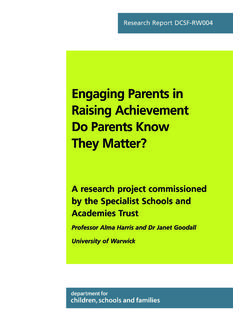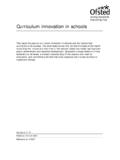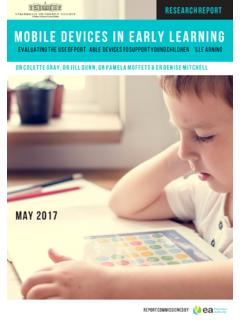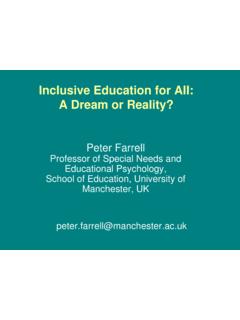Transcription of Absence from School: A study of its causes and effects in ...
1 R ESEARCH. Absence from school : a study of its causes and effects in seven LEAs Heather Malcolm, Valerie Wilson, Julia Davidson and Susan Kirk The SCRE Centre, University of Glasgow Research Report RR424. Research Report No 424. Absence from school : a study of its causes and effects in seven LEAs Heather Malcolm, Valerie Wilson, Julia Davidson and Susan Kirk The SCRE Centre, University of Glasgow The views expressed in this report are the authors' and do not necessarily reflect those of the Department for Education and Skills.
2 Queen's Printers 2003. ISBN 1 84185 992 3. May 2003. ii Contents Page Acknowledgements / Glossary v Executive Summary vi 1. The Research Project 1. Introduction 1. Aims and questions 1. Sample and method 1. The report 3. 2. The Absence Problem 5. Key findings 5. Introduction 5. Views from LEAs 6. school perspectives 7. Pupils' profile 9. Chapter summary 12. 3. The effects of Absence 13. Key findings 13. Introduction 14. school staff perspectives 14. Pupils' perspectives 22. Comments from regular attenders 23.
3 Chapter summary 25. 4. The causes of Absence 27. Key findings 28. Introduction 28. Primary school pupils' views 28. Secondary school pupils' views 31. Views from LEA and school staff 33. Chapter summary 37. 5. Parental Involvement 39. Key findings 39. Introduction 39. Attitudes to school and attendance 40. Parents' views of why children miss school 42. When did pupils think parents would sanction Absence ? 44. Chapter summary 45. 6. Ways of Improving Attendance 46. Key findings 46. Introduction 47. Views from the LEAs 47.
4 Other professionals' views 50. school registration and immediate follow-up procedures 51. school strategies to promote good attendance 52. school strategies to deal with poor attendance 54. Effectiveness of measures dealing with attendance 57. Chapter summary 58. iii Working for Democracy: Review of Community Education Training 7. Discussion and Comment 60. Key findings 60. Introduction 61. More primary school children truant than was believed 61. Truancy becomes a habit 61. Girls do truant 62. Pupils' and parents' views on Absence differ from those of 62.
5 Education professionals A school focus within a framework of multiple strategies 63. Criteria for recording absences 64. Key Stage 2 and 3 tests in Years 6 and 9 64. Multi-agency links need further development 64. Improvement in attendance levels is slight 64. Absence is expensive in staff time 65. Absence has other costs 65. In conclusion 66. Bibliography 67. Appendix 1 68. List of tables Some characteristics of the project primary schools 2. Some characteristics of the project secondary schools 2.
6 Data collection methods by types of data providers 3. Percentage of boys and girls responding yes' to four questions 10. Self-reported truants in all-white secondary schools 11. Self-reported truants within secondary, mixed ethnicity schools 11. Primary school pupils reporting truancy without parental collusion 28. Primary school pupils' responses to five imaginary situations 30. Primary school pupils' responses to two situations suggesting 30. condoned Absence Characteristics of parent/guardian providing information 40.
7 Racial heritage of parent/guardian 40. Why children miss school : all respondents 42. Action by parents unhappy with their children's school attendance 43. Situations in which primary pupils thought their parents would condone 44. Absence List of figures Percentage of primary school pupils first skipping school at various ages 10. Proportions of parents agreeing with various statements about attending 41. school Parents' views of when children should miss school 41. iv Acknowledgements This study would have been impossible without generous assistance from many sources.
8 The SCRE Centre would like to thank: staff, pupils and parents who generously completed questionnaires or agreed to be interviewed Professor Heidi Mirza of the Centre for Racial Equality Studies, University of Middlesex for advice on equal opportunities Paula Davidson, Sheila Edward, Kevin Lowden, Joella Hazel, Ann Marie Sheridan and Ursula Schlapp for their valuable research assistance all members of the Advisory Committee for their support throughout the work;. and the secretaries within SCRE, whose patience has been unfailing.
9 Glossary of Acronyms DfES Department for Education and Skills EDP Education development plan ESWO Education social welfare officer ESWS Education social welfare service EWO Education welfare officer EWS Education welfare service FSM Free school meal KS2, KS3 Key Stage 2, Key Stage 3 etc LEA Local Education Authority OMR Optical mark recognition PSHE Personal, social and health education SATs Standard assessment tests. Those referred to in this report are taken at Key Stage 2 in Year 6 and Key Stage 3 in Year 9.
10 Key Stage 1 tests are taken towards the end of Year 2. SCRE Scottish Council for Research in Education Centre SEN Special educational needs SPSS Statistical Package for the Social Sciences Y5, Y6 Year 5, Year 6 and so on; ie the fifth year of compulsory schooling, the sixth year and so on v Executive Summary Introduction The issue of school attendance is currently the focus of intense activity in schools and LEAs in England. It is also a high priority policy concern (DfES, 1999; DfES, 2002) for which the Government has set a target to reduce levels of non-attendance by one third by 2002.

















